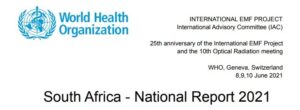“The questions may be the same but the answers have changed”
Link to the report: https://bit.ly/3HkQ4vh
6 free informative videos (applicable internationally).
Each video has detailed timestamps.

Electrohypersensitivity (EHS): Similar to findings in IT, FR, and the NLs, a number of individuals have reported a variety of health problems that they relate to EMF exposure at home and in the workplace. Rulings have acknowledged that EMF-related health issues could result in workplace-related accidents or illness. The biggest obstacle to date has been identified as the miscommunication of, and the misunderstanding of the specific interactions between EM and biological organisms. Different EM spectrums can bring about different symptoms. Population vulnerability and bio-adaptation vary between mtDNA haplotype groups. The use of the term Electromagnetic hypersensitivity (EHS) has brought about further confusion and miscommunication. This is a result of bodies not adhering to the Climate Change Framework scientific-technical analysis for compensation mechanisms which defines the parameters of classification as Sensitivity, Adaptability, and Vulnerability. This has been further explored in the 2017 SA govt. published study. The organs of state reviews have endorsed efforts toward adaptability strategies so that vulnerability can be reduced by strengthening adaptive capacity. It is for this reason that the decision has been taken to help update the teaching curriculum in medicine with biophysics in an effort to address these misunderstandings. The study into the model development surrounding “EHS” has not only brought about better understanding but also advanced cost-effective treatments into other epigenetic and genetic disease models.
In SA, the capacity of EMF to affect biological functions has been investigated and confirmed in reviews of the Ombudsman, Commission, Magistrate, and High Court. The WHO health and disabilities publication uses “disabilities” as an umbrella term to cover a wide range of conditions. The term “disabilities” covers impairments, activity limitations, and participation restrictions. An impairment is a problem in body function or structure; an activity limitation is a difficulty encountered by an individual in executing a task or action; while a participation restriction is a problem experienced by an individual in life situations. Disability is thus not just a health problem. It is a complex phenomenon, reflecting the interaction between features of a person’s body (including physical, mental, neurological) and features of the society in which he or she lives. Overcoming the difficulties faced by people with disabilities requires interventions to remove environmental and social barriers. This makes it clear that people must be able to participate in society, function independently, and remain in their own living environment for as long as possible. Multiple international regulations confirm municipalities must promote this by virtue of providing facilities, assistance, and support. The government’s strategy toward bio-adaption solutions is not only showing promise for persons with “EHS” type complaints but also has benefits in other spheres as well.
PDF https://www.emfsa.co.za/wp-content/uploads/2021/06/World_Health_Organization_International.pdf
available from:
Academia
AND
Researchgate